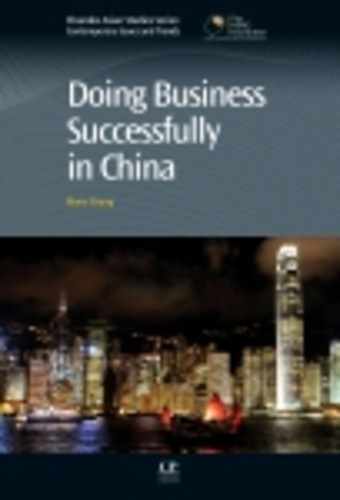Index
banqueting, 160–4
beer consumption, 187
behaviour, 55–8
normal vs aggressive, 137–9
Book of Rites, 162
bottle returns system, 185
brand names, 189–95
China, 1–7
operating licence, 122–4
Carlton & United Breweries, 184
‘cause and effect’ method, 54
centrally planned economy, 94–5
China Iron and Steel Association, 47
Chinese consumers, 3–5
product marketing, 177–215
Chinese culture, 82
Chinese market, 179–82
Chong Yang Festival, 164
chopsticks, 162–3
Chung Model, 35–41
critical point, 38–41
cross-cultural communication, 36
goals, 37–8
Chunqiu period, 157
collectivist/individualist paradigm, 51
Chinese, 9–32
culture context and cross-cultural communication, 9–14
communication models, 10–11
Shannon–Weaver Mathematical Model, 10
competency, 107
competitive nature, 145
compromise, 60
concept of contract, 138
Confucianism, 130–1
five formal relationship, 135–7
consistency, 112–13
consumer perception, 209–10
context, 10
continuum of high and low context cultures, 130
contracts, 6
corporate communication, 213
Critical Point, 38–41
culture context, 12–14
interpreters, 26–32
cross-cultural management, 105–24
Chinese systems and styles, 113–17
consistency, 112–13
distinction between Chinese, 106–7
duties, 120–2
effect on performance, 107–8
Expatriates’ psychological barriers, 117–20
management personnel, 108–12
cultural behaviour, 213–15
Cultural Capability Theory, 55–61
cultural factor, 45
cultural intelligence quotient, 57
negotiations, 127–51
culture, 91
culturally suited strategy, 98–100
evolution, 174–5
hierarchy and harmony, 146–8
impact on negotiation, 129–31
investment process, 96–8
marketing strategies, 178–80
mindset and impact, 91–102
obstacles to negotiations, 127–51
CVRD, 46
degree of control, 73–4
direct-municipal cities, 80
Dove, 204
Duanwu Festival, 164–5
Dutch East Indies Company, 67
and business prosperity, 155–75
environment and health connection, 157–60
rules and rites, 160–2
table manners, 162–3
understanding the role of eating and drinking, 156–7
education revolution, 143–5
egalitarian power relationships, 51
ethical practice, 166
European Pallets Association, 99
Expatriates, 117–20
‘eye-ball’ economy, 204
federalism, 134
fenli, 160
financial loss, 92–3
financial management, 123
five elements, 158
Five Star, 185
five-year plan, 94–5
‘flying squad’ approach, 184–6
environment and health connection, 157–60
rules and rites, 160–2
food allergy, 159
food offering, 160
assessing methods of entry, 71–3
Chinese role, 83–6
complex option, 66
degree of control, 73–4
Foster’s entry and growth strategy, 80–1
historical overview, 67–8
joint venture, 74–8
local knowledge, 81–3
modern challenge of China, 67–8
three waves of investment, 69–71
’22 families’, 121–2
brands, 189–95
distribution, 197–9
entry and growth strategy, 80–1
joint ventures, 183–4
management personnel, 108–12
market research, 93–6
marketing strategies, 178–80
packaging and labelling, 195–7
gender, 52
George Patterson, 188–9
‘golden keys to negotiation’, 53–4
government allocated financial resources, 95
Great Wall, 192
gross industrial output, 94
Guangdong White Horse Marketing Research, 188–9
guanxi, 138
hanxu, 11
healthcare industry, 70
hierarchical power relationships, 51
High Context/Low Context culture, 12–14
high power-distance theory, 117
‘high trust’ culture, 134
Hong Kong marketing firms, 205–6
Honglin, 39–40
Huangmei Fruit Beer, 192
individualism, 133
intelligence theory, 57
interpreters, 26–32
investment process, 96–8
investment risk, 74–8
management personnel, 108–12
Maoism, 132–5
local market, 201–2
accuracy, 184
marketing, 205
strategies, 178–80
Maslow’s hierarchy of needs, 118
mindfulness, 57
miscommunication, 19–21
mono-cultural negotiators, 59–61
nail-production market, 99–100
negotiations, 6–7
Australian-Chinese, 139–41
Chinese characteristics, 43–61
Chinese perspective, 48–50
complex task, 150–1
cross-cultural, approaches in, 52–5
Cultural Capability Theory, 55–61
cultural obstacles, 127–51
definition, 44–5
different approaches, 128–9
gender, 52
high vs low context cultures, 130–7
impact of culture, 129–31
order of arguments, 48
Rio Tinto and BHP Billiton, 45–8
team spirit, 51
value of power, 51–2
non-directed consumer focus group, 189
peizhe, 14
personal selling, 210–12
pingguo, 160
Power’s, 192
power, 51–2
accurate market research, 188–9
advertising, 207–9
brand names, 193–5
brands, 189–95
Chinese consumers, 177–215
Chinese market, 179–84
consumer perception, 209–10
cultural behaviour, 213–15
culturally suited strategies, 178–80
distribution, 197–9
‘flying squad’ approach, 184–6
Hong Kong marketing firms, 205–6
lack of knowledge, 186–7
local market on a global scale, 202–3
local marketing knowledge, 201–2
packaging and labelling, 195–7
personal selling and other sales techniques, 210–12
promotional communication, 203–5
suitability of joint ventures, 183–4
transport infrastructure, 199–200
product quality, 178
promotional communication, 203–5
psychological barriers, 117–20
rangchai, 162
Reeb, 209
Regal, 209
Rio Tinto, 45–7
rote learning, 143
3Rs: relax, repair and reciprocate, 170–1
sales techniques, 210–12
Shanghai Dragon, 190
Shanghai Modern International Research, 188–9
shanglan, 157
Shannon–Weaver Mathematical Model, 10
simulation, 140
participants, 140–1
single-child policy, 145
suppliers’ conference, 167–69
‘The Law of the People’s Republic of China on Chinese–Foreign Joint Ventures’, 69
Tianjin Brewery, 82
transport infrastructure, 199–200
‘two into one’ tax system, 70
..................Content has been hidden....................
You can't read the all page of ebook, please click here login for view all page.
